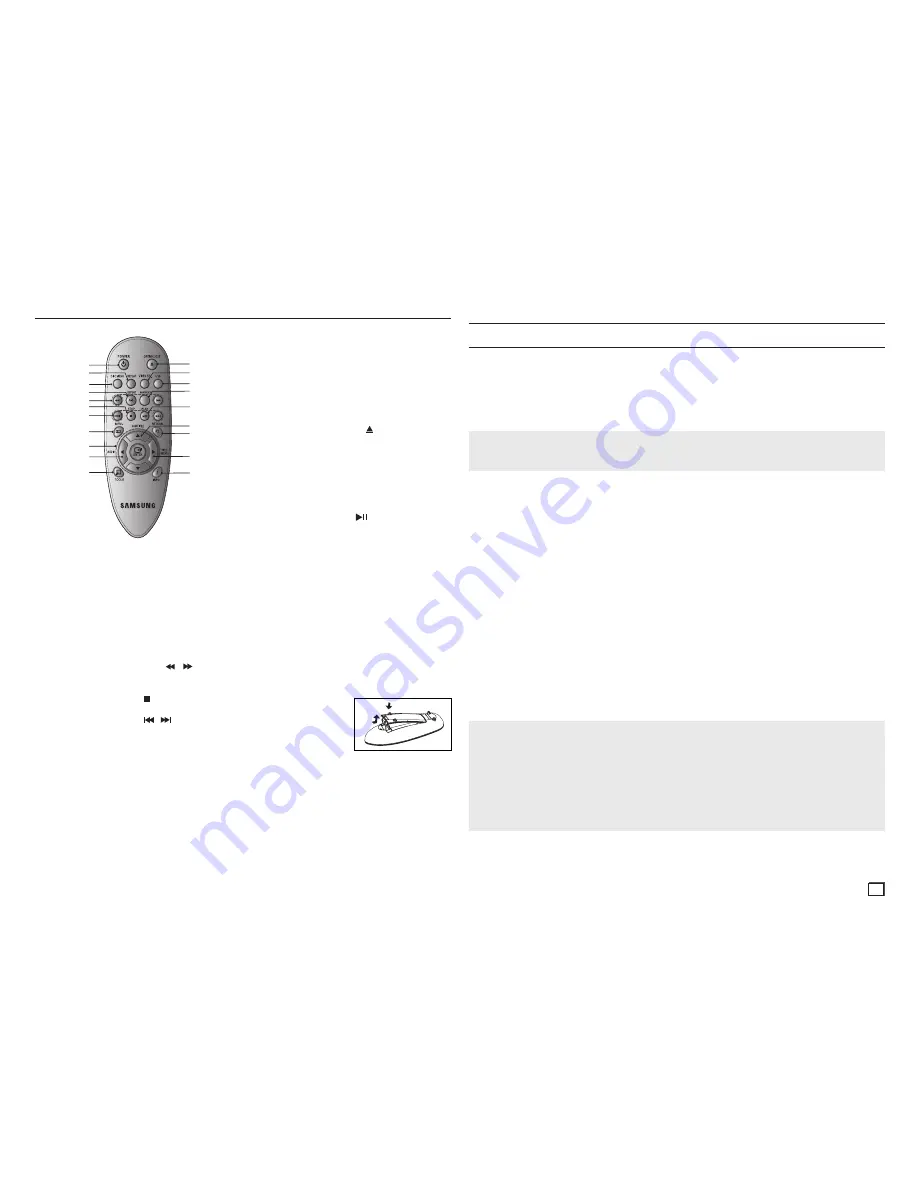
5
Install batteries in the Remote
Control
1.
Open the battery cover on the back of the
remote control.
2.
Insert two AAA batteries. Make sure that the
polarities (+ and -) are aligned correctly.
3.
Replace the battery cover.
Tour of the Remote Control
1
2
3
4
5
6
7
8
9
10
11
12
15
16
17
18
19
14
13
20
1.
DVD POWER button
Turns the power on or off.
2.
REPEAT button
Allows you to repeat play a title, chapter, track,
or disc.
3.
DISC MENU button
Brings up the Disc menu.
4.
REPEAT A-b button
Allows you to repeat a chosen section
(A-B) on a disc.
5.
SEARCH buttons (
/
)
Allows you to search forward/backward
through a disc.
6.
STOP button (
)
To stop the disc
7.
SKIP buttons (
/
)
Use to skip the title, chapter or track.
8.
MENU button
Brings up the DVD player’s menu.
9.
ENTER/
π
/
†
,
√
/
®
buttons
This button functions as a toggle switch.
10. AUDIO button (
√
)
Use this button to access various audio
functions on a disc. Use this button to select
an available TV source (mode TV).
11. TOOLS button
Displays the current disc mode. It also
lets you access the Display function.
12. OPEN/CLOSE (
) button
To open and close the disc tray.
13.
MARKER
Quickly find bookmark sections of a DVD.
14. USb button
To change device which access to USB device.
15. VIDEO SEL. button
Changes video output mode.
16. PLAY button (
)
Begins disc play.
17. SUbTITLE/(
π
) button
18. RETURN button
Returns to a previous menu.
19. TITLE MENU button (
®
)
Brings up the Title menu.
20. INFO button
Displays the current playback information.
Connections
Choosing a Connection
The following text explains how to make connections commonly used to connect the DVD player with a TV
and other components. A diagram showing these connections is to the right.
before Connecting the DVD Player
- Always turn off the DVD player, TV, and other components before you connect or disconnect any cables.
- Refer to the user’s manual of the components (such as a TV) you are connecting for more information on
those particular components.
A. Connecting to a TV Using the Video Jack (Video)
1.
Using Video/Audio cables, connect the
VIDEO
(yellow)/AUDIO (red and white) OUT
jacks on the
rear of the DVD player to the
VIDEO (yellow)/AUDIO (red and white) IN
jacks of your TV.
2.
Turn on your DVD player and TV.
3.
Press the input selector button on your TV remote control until the Video signal from the DVD player
appears on the TV screen.
b. Connecting to a TV Using the Component Jacks (Progressive/
Interlace)
- Connecting through the Component jacks lets you view video at the 480p (Progressive Scan) resolution.
- What is "Progressive Scan"?
Progressive scan has twice as many scanning lines per frame as interlaced (480i) output and provides
better and clearer picture quality.
1.
Using Component video cables (not included), connect the
COMPONENT VIDEO OUT
(PR, PB and
Y) jacks on the rear of the DVD player to the
COMPONENT IN
(PR, PB and Y) jacks of your TV.
2.
Using the audio cables, connect the
AUDIO (red and white) OUT
jacks on the rear of the DVD
player to the
AUDIO (red and white) IN
jacks of your TV. Turn on the DVD player and TV.
3.
Set the Video Output to
P-SCAN/I-SCAN
in the Display Setup menu. You can also use the
VIDEO
SEL.
button to change the Video Output mode.
4.
Press the input selector button on your TV remote control until the Component signal from the DVD
player appears on the TV screen.
Notes
- Noise may be generated if the audio cable is placed too close to the power cable.
- If you want to connect to an Amplifier, please refer to the Amplifier connection section below.
- The number and position of the jacks on your TV may vary depending on your TV set. Please refer to
the user's manual of your TV.
- If there is one audio input terminal on the TV, connect it to the [AUDIO OUT] [left] (white) jack of the
DVD player.
- If you press the VIDEO SEL. button when the DVD Player is in stop mode or no disc is inserted,
the Video Output mode changes in the following sequence : I-SCAN
➝
P-SCAN (Interlaced
➝
Progressive).
Notes
- The first time you turn on your DVD player, the Language Selection screen appears. See
Selecting a Language on page 6 for details.
















